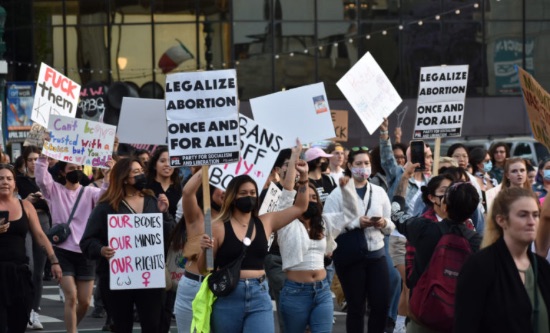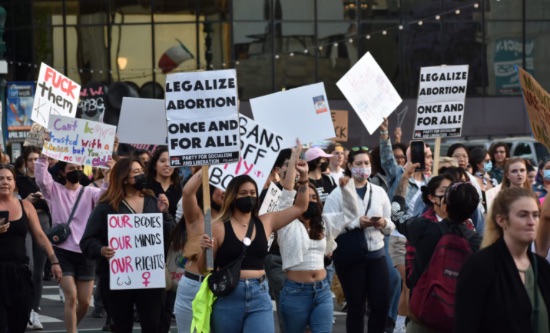
On 2 May the US political news website Politico published a leaked draft opinion by one of the powerful Supreme Court Judges currently considering a case which will have a deep and far-reaching effect on women across the US. For five decades the 1973 case of Roe v Wade has provided a legal basis for women’s right to abortion. Without safe access to pregnancy termination millions of women will be at risk from ‘back-alley’ abortions, pregnancy complications, or being trapped in unsafe domestic situations. This is part of a global attack on women as capitalism falls deeper into crisis. ANNIE O’CONNER reports.
The inevitable overruling
The 1973 Roe v Wade ruling, later upheld and cemented in the 1992 Planned Parenthood v Casey case, set a precedent for women’s right to abortion in the US. In 1973 a woman under the pseudonym ‘Jane Roe’ filed a lawsuit in the US federal court alleging Texas’ abortion law, under which abortion was illegal unless it was necessary to save the mother’s life, was unconstitutional. The court voted seven to two in favour of Roe. The decision was based on the Fourteenth Amendment’s ‘right to privacy’ concerning medical care, wherein US states are prohibited from placing legal restrictions that cause ‘undue burden’ on abortion access in the first trimester. It gave women in the US limited federal protection to choose abortion, rather than abortion laws being left entirely up to individual states, as was previously the case.
The rulings came after a sustained campaign led by women. The 1970 nationwide Women’s Strike for Equality was supported by tens of thousands in New York City alone. However, the overturning of Roe v Wade has always been a question of when, not if. The ruling has come under attack numerous times since 1973, both on the streets by anti-abortion terrorists and with legislation.
Between 1977 and 2020 abortion providers experienced some 860,396 violent incidents, including 956 death threats, 368 violent assaults, 42 bombings, 11 murders and 26 attempted murders by ‘pro-life’ terrorists.
Since 1973, various reactionary US states have tried different strategies to evade the precedent set by the Supreme Court. In September 2021 Texas was able to get around the federal law and effectively ban abortion once a foetal heartbeat can be detected – usually by around six weeks. It achieved this by empowering individuals to sue anyone who performs or facilitates an illegal abortion, rather than requiring state officials to do so. 561 abortion restrictions were enacted in at least 47 states in 2021 alone.
States can currently only be forced to remove abortion restrictions by the reactionary local legislation itself being challenged in the state courts, after it has become law. From there it can be taken to the Supreme Court, where the Supreme Court Justices can use Roe v Wade to retroactively shut down the restrictive legislation. This shows how Roe v Wade is purely defensive and depends entirely on a supportive Supreme Court that would be willing to uphold the 1973 ruling again and again whenever a case is brought before them. If more than four of the nine Supreme Court Justices are anti-abortion and anti-women’s right to choose, they can oppose the 1973 ruling and instead use the case being brought before them to overturn the precedents of Roe v Wade and Planned Parenthood v Casey.
This is what is happening. In 2018 Mississippi passed the ‘Gestational Age Act’ which bans abortion after 15 weeks. The state’s only abortion clinic, Jackson Women’s Health Organisation, immediately sued the state – including Thomas Dobbs, representative of the Mississippi State Department of Health. The case was brought to the US District Court of Mississippi, where the judge ruled in favour of Jackson Women’s Health. However, Dobbs appealed the verdict and petitioned to have it brought to the Supreme Court.
The Supreme Court, now stacked with anti-abortionists, is expected to vote in favour of Dobbs to overturn Roe v Wade and allow the Gestational Age Act to remain in place. The leaked draft published by Politico was the opinion piece written by Supreme Court Justice Samuel Alito, who belongs to the majority who want to vote in favour of Dobbs and overturn Roe v Wade. In the opinion, Alito writes: ‘Roe was egregiously wrong from the start. We hold that Roe and Casey must be overruled.’ The final decision will be announced in July.
Given the majority shown in the draft opinion, it is probable Roe v Wade will be overturned. If it is, at least 38 states are expected to either immediately effectively ban abortion outright via ‘trigger laws’ or soon pass laws that do so. This will be a devastating blow to women’s rights in the US.
Where were the Democrats?
The Democrats sat on their hands when it came to codifying protection of Roe v Wade into law as was promised by Joe Biden in his presidential campaign. Only after the mass demonstrations against the leaked draft did the Democrats put the Women’s Health Protection Act – which would codify the right to abortion into law – to the Senate. It did not pass.
During Barack Obama’s presidency between 2009 and 2017, the Democrats at one point controlled both the Senate and the House of Representatives. They could have expanded the number of Supreme Court Justices so as to appoint liberals who supported abortion rights. They did not. Abortion rights served as a campaign tool to lure the Democratic left. This led to the Court becoming a conservative majority under Donald Trump as he appointed three Justices.
The overruling will almost certainly have further implications for other Court decisions that hinge on the ‘right to privacy’ such as Griswold v Connecticut, 1965, that protects the purchase of contraceptives without government restriction. The Democrats have shown themselves to have no interest in improving material conditions for the working class, and certainly not for working class women. Same-sex relationship rights are also at stake. Laurence v Texas, 2003, which is explicitly criticised by Alito in his draft opinion, used ‘right to privacy’ to determine that it is unconstitutional to punish people for committing ‘sodomy’.
Global reaction against women
The attacks on reproductive rights in the US must be seen as part of a much wider, global reaction against women. In times of capitalist crisis, the dual oppression of women as both privatised domestic workers and socialised commodity producers – making up a key section of the reserve army of labour – is intensified (see Women’s oppression under capitalism, Larkin Publications, 2021). Women are forced back into the home to reproduce the labour force and replenish the working class’ ability to labour as state services are cut. The ideological attack on women is used as a divide and rule tactic to justify this oppression and weaken working class resistance.
In the US, this expresses itself by reinforcing the narrative of women as ‘breeders’ and attacking abortion rights. In Europe, countries such as Poland and Hungary have made abortion impossible. In Latin America, there is very little access to abortion or sexual health services across the continent.
In Britain, the primary mechanism for ruling class attacks on women has been the erosion of state services and provisions. The coronavirus pandemic exposed these attacks: women were forced out of the workplace and into the home, where the British state could rely on women to fill the gaps left by diminishing state services. Mothers were twice as likely as fathers to have to be off work with no pay.
Abortion in Britain is legal under the 1967 Abortion Act (though not on demand: it remains dependent on authorisation by two doctors), but when the NHS is being gutted, women’s services are the first to go. Over 70% of NHS funded abortion services are now performed by private clinics.
Research revealed that 49% of women accessing illegal telemedicinal abortion pills in Britain cited long wait times as a barrier to accessing abortion on the NHS, sometimes being given wait times that would take them over the threshold for medication induced abortion and would force them to endure a surgical procedure. The second most common barrier was mothers being unable to find childcare or transport to clinics that were often hours away.
Socialism is survival
In the US, the most important precedent for women’s autonomous reproductive control rests entirely on nine unelected people. Compare this to socialist Cuba. Abortion was decriminalised in 1965 and since 1979 has been free, legal, available on demand for the first ten weeks of pregnancy and readily accessible to the entire population. In February 2022 Cubans began a three-month long consultation of the entire population as part of the reform of the Family Code of 1975. The reforms were designed to reflect contemporary Cuban life and introduce more considerations for gender and sexual equality and children’s rights. The consultation involves debates between all Cubans in their workplaces and their communities over the exact contents of the draft legislation, which legislators feed back into updating the Code. The updated legislation is then subjected to a referendum before it is ratified. This is the process for deciding all major political, economic, and social questions in the country.
In Cuba, women’s liberation was only achievable with a socialist revolution where women played a leading role. Before the revolution, abortion was illegal and 83% of employed women worked less than ten weeks a year. The revolutionary fighter Vilma Espin founded the Federation of Cuban Women in 1960 that organised Cuban women and girls to fight for the revolution and fight for their interests within it. Espin pioneered the Family Code which came into effect on International Women’s Day 1975 following intense debate within the Federation. Today, Cuban women make up more than half of the Cuban government. While there is still work to be done, ‘the revolution [is] totally committed to struggling against racism and sexism in all their forms’ (Assata Shakur, FRFI 131).
The USSR, the first socialist state, offered free abortion in 1920, the first country in the world to do so. There was generous maternity leave and a network of childcare to alleviate domestic burdens from individual families, so women were able to participate in political and social life.
Unsafe abortion
Today, worldwide, over 21 million women are forced into having dangerous ‘backstreet’ abortions every year. Around six million of these women face serious complications, including death. If Roe v Wade is overturned, it seems inevitable it would once again have a drastic impact on US funding for reproductive health organisations in underdeveloped countries. The attack on abortion rights in the US will be devastating, particularly for working class and black and Hispanic women who will be disproportionately impacted. Abortion access is a class question: those without access to money and resources cannot travel out of state or to another country to have their abortion. They will be increasingly forced into having illegal abortions.
A national NBC News Poll in May found two thirds of people in the US oppose overturning Roe v Wade. Since the draft opinion was leaked, protests have been taking place across the country. The fight for free, safe and accessible abortion in the US will require a sustained campaign on the streets that breaks from the confines of the reactionary Democratic Party.
Fight Racism! Fight Imperialism! no 288, June/July 2022




